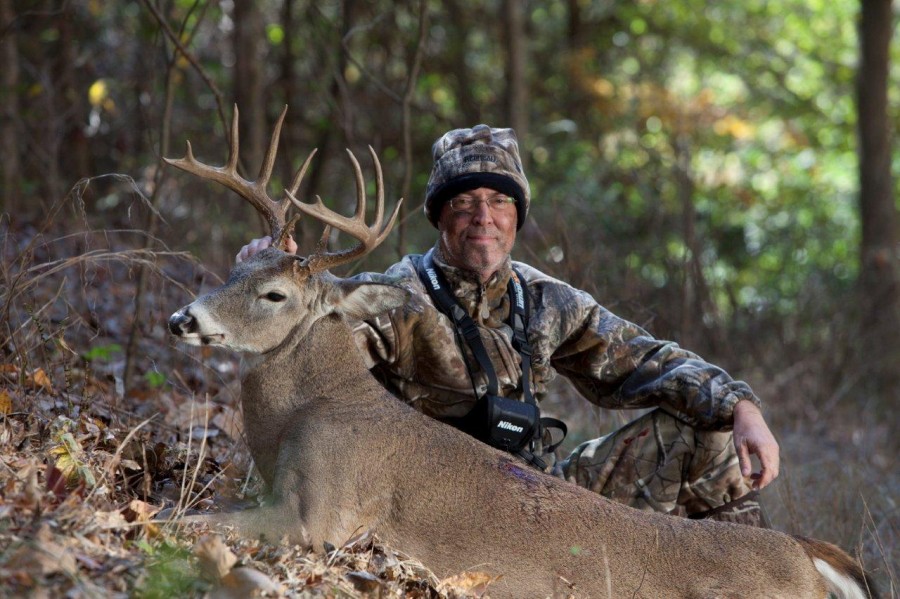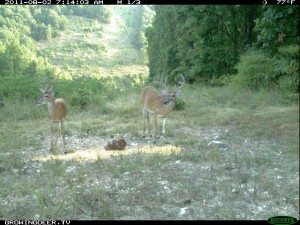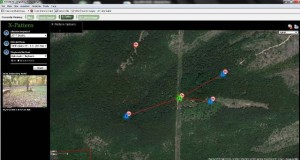Patterning A Mature Buck
Filed under: Bow Hunting, Deer Hunting, Hunting Blog, Hunting Tactics, Trail Cameras
I grew up rabbit hunting. It was the game of choice as there wasn’t a deer season in the county where I was raised. One of my favorite pastimes was tracking or back tracking rabbits in the snow. I probably learned more about rabbits and rabbit hunting by back tracking rabbits in the snow than I did from anything else with the exception of invaluable lessons from my grandfather and father (they were incredible rabbit hunters). In hindsight, those lessons were of huge value to me as a deer biologist and hunter. I learned that critters need food, cover, and water and will use the path of least resistance to move from one to another AS LONG AS THEY DON’T FEEL THREATENED ALONG THOSE PATHS.
The same is true for mature bucks. They need food, cover, and water on a regular basis and will move between these resources along the path of least resistance as long as they don’t feel threatened. One of my hunting tactics is to determine if there are mature bucks in the area by using Reconyx cameras and then use aerial photos to locate the likely sources of food, cover, and water close to the camera that photographed the buck. Notice that I didn’t say I moved the camera to monitor the sources of food, cover, and water. One of my keys to success is being very aware of the bold words in the previous paragraph – AS LONG AS THEY DON’T FEEL THREATENED ALONG THOSE PATHS.

Most of my neighbors hunt and deer are constantly being alerted during the season in my neighborhood. I know deer will range off my property. However, I want to encourage them to spend as much time on my property during daylight hours as possible. That’s one reason why I created sanctuaries! Deer, even during the rut, will likely spend most of the day resting in thick cover. If I can protect bucks during the day, they will have a good chance of surviving to maturity. In addition, if mature bucks are conditioned to finding safety in the same area (sanctuaries), then it’s easier to pattern them.
I used this strategy last Friday to kill a buck I had named Clean 12. It was a great hunt as I watched the buck for more than 10 minutes including watching him make a scrape, thrash some limbs with his antlers, and vocalize a snort wheeze. I ended up shooting Clean 12 at three yards! It was a thrilling hunt!! However, what made this encounter with Clean 12 work was simply applying the strategy outlined above.
I had obtained several Reconyx images of Clean 12 during the late summer. I placed some Reconyx cameras in open areas such as Trophy Rock stations and food plots to get a feel for his range and travel patterns.
I knew I wouldn’t likely hunt at any of those camera stations  because they were in open areas. Mature bucks would rarely visit them during daylight once season opened. I then used my knowledge of the closest locations for food (used mainly at night by mature bucks this time of year), water (several springs and seeps in the area so no way to predict which source he might use), and cover.
because they were in open areas. Mature bucks would rarely visit them during daylight once season opened. I then used my knowledge of the closest locations for food (used mainly at night by mature bucks this time of year), water (several springs and seeps in the area so no way to predict which source he might use), and cover.
Years ago I had created a sanctuary at the east end of the area where I had images of Clean 12. It seemed the obvious bedding area for Clean 12 . It was the most limiting of three needs a deer has daily (food, water, and cover) in the portion of his range I had confirmed. In addition, I could approach from the east and not enter the area where I had patterned him mainly at night. A northwest, west, or southwest wind would be perfect for the area between where I knew Clean 12 was using and the sanctuary. This area is a de facto transition zone. Deer shouldn’t feel threatened moving into the sanctuary so the site I picked to hang my Muddy stands was the path of least resistance. Finally, the sanctuary was lower in elevation than the ridge where I had determined Clean 12 was using at night and the thermals would be pulling scent downhill (east) and away from where I predicted Clean 12 would be coming from toward the sanctuary.
With my plan in place, Adam (my cameraman) and I were able to approach our stands without alerting deer anywhere to the west of us. About 9 am, I spotted a buck 70 yards away moving toward the bedding area. The habitat work, placement of the Reconyx cameras, and Muddy stands had paid off. You can see the events that occurred when Clean 12 closed the last 70 yards on GDTV 101.
Growing (and hunting) Deer together,
Grant



